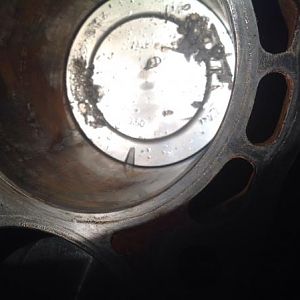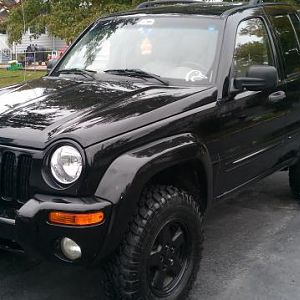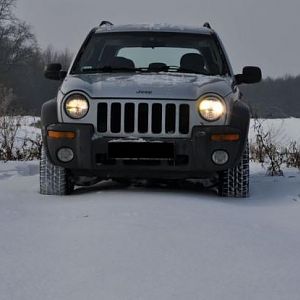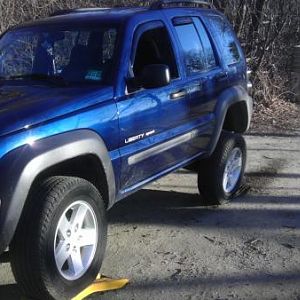ol-flattop
Full Access Member
Yesterday evening, fueled by turkey, taters, cranberry sauce, and delicious homemade pies of every sort, I finally tackled the fuel burp issue that has plagued my KJ since I bought it. One Liberty write-up has been done, but it was pretty abstract and didn't get much attention. So, since there’s been some renewed interest in this topic and there's still a void to be filled, here is a thorough set of instructions. With the benefit of hindsight, I’m putting them in a different order from the way I did it. It took me quite a while to get done, mostly because I kept trying to save time by leaving the jeep together as much as possible. That turned out to be pretty dumb, and I’ll try to save you the time and hassle.
For background info, there’s a problem with some KJ’s, shared by some JK’s, where you can’t let a fuel pump keep going all the way to auto-shutoff without fuel spurting back out at you. Some people, for no apparent reason, continue to deny that this problem exists because their particular KJ doesn’t experience it. Others confuse it with another problem that manifests itself in the opposite way (i.e. the auto-shutoff is actuated when the tank is nowhere near full), or else they assume that it can only occur when users try to ‘top off’ the tank by adding more fuel after the auto-shutoff has already been activated. Here’s a youtube vid showing this particular problem.
(In the interest of full disclosure, this paragraph is just my understanding of the problem based on web research. It’s not the authoritative source, just the best explanation I’ve seen, in the absence of costly scientific testing.) The problem is apparently caused by the fuel tank rollover valve, which has the dual purpose of preventing fuel from pouring out of your tank if you, well, roll over, but also of preventing fuel from belching back out of the tank when you fill it. This valve, at least on some KJ’s, includes a rubber gasket which in theory should make it super-duper effective. But when it comes in contact with ethanol, the rubber expands, binding the valve and preventing it from closing. So, you end up with a nice smelly burp of gasoline at the end of each fill-up, unless you approach the mundane task of pumping gas with the same care a skilled neurosurgeon employs in digging around someone’s brain. No fun. Jeep has quietly ignored the issue, apparently to avoid admitting they made yet another mistake. I’m told they will fix it, if asked to, by replacing the entire gas tank, since the rollover valve is integral to it. I presume the new tank will have a different gasket that handles ethanol better, but (shockingly) it’s tough finding people willing to foot an $800+ bill just because of the fuel burp issue, so there’s not much info to go on.
For some reason, not all KJ’s are plagued by this problem, and it doesn’t seem to be a large proportion that has the issue. Since ethanol supplementation has become pretty much pandemic and thus can’t be the determining variable, my speculation is that the rubber gasket on the fuel tank rollover valve is only present on models with the California emissions package. I’m hoping for some feedback from those who experience this problem—do your Jeeps have this package, as mine does? You’ll have to check your build sheet or engine bay to find out for sure. Of course, one or two who have the fuel burp issue but not the CA emissions package would blow my theory out of the water, but if so please share! I’m interested in finding out the truth, not being proven right.
Whatever the reason, our Jeeps are barfing out gasoline like a baby gorged on mama’s milk. You can only find it cute for so long, and then it needs to stop! To that end, let’s get started!
1. Get GM part 15131046HOSE (I used ebay, shop around and you'll find a good price), and cut out the flapper valve from the center using a razor utility knife. Be careful not to damage the valve. Or yourself. While you’re at it, you might as well salvage the hose clamp on the end—just snip that claw off. I used it later, in step 13.
2. Get some plastic pop rivets. My searching of LOST, Jeepforum, and KJ country turned up Napa part # BK 7702871 for this, but they weren’t a perfect match. Close enough for jazz, though. Here’s the Napa rivet next to a removed Jeep rivet.
Contrast that to one of the Harbor Freight rivets that came with the rivet tool (coming up in step 3!), which is a nearly perfect match. Emphasis on ‘nearly,’ there, for reasons to be seen later.
3. Get a riveter. You’d think a regular one would work just fine, but the two I tried didn’t have a collet large enough to fit the Napa rivets. There was one just large enough for the HF rivets, but I couldn’t get it to release the waste portion of the mandrel. This one from Harbor Freight worked like a charm, and cost 16 bucks. As a bonus, it happened to come with an assortment of rivet sizes, one of which, mentioned above, is almost identical to the Jeep rivets. If you’re on a really tight budget, you can get the rivets alone for 6 bucks or so and make them work using two pairs of pliers, some patience, and probably a list of expletives, but there’s a reason they make a tool specifically for this job.
For most, those are the only two/three purchases you’ll have to make for this job. I got the GM hose for $25, and the HF tool and rivet assortment for $16, for a grand total of $41 (+tax) invested in this fix.
4. Jack up the rear driver’s side, stick a stand under the axle, and remove the wheel. You could probably get the job done without this, but it takes two minutes and makes everything that follows much easier.
5. Remove the four rivets visible below from the rear fender flare. You don’t need to touch the one on the bottom at the rear (out of view), or the ones on the front panel of the fender flare, just these four.
I did this using a variety of tools and methods, but the most effective is to use an appropriately sized drift punch (yeah, all I had on hand was a small screwdriver, which works but isn’t ideal) and hammer to drive the mandrel in, collapsing the rivet on the other side. Once it’s loose, you can use a claw hammer, pry bar, or sometimes just your fingers to pull the whole rivet out.
6. Next, remove the three plastic push-rivets that secure the wheelhouse liner to the wheelhouse behind it. I was able to get a small prybar behind the liner in all three spots to remove the rivets without ruining them, but there are also tools made specifically for this task, which will make it a tad easier.
7. Pop out the wheelhouse liner. Toward the front of the jeep, the liner just meets the fender flare with very little overlap and no attachment except the push rivet you just removed. Start there, then pull the center down and toward you, and finally the whole thing will pop out nicely.
Now you have easy access to everything you need.
If you really wanted to, you could probably get the job done without accessing the fuel hose from the wheelhouse as described above. But it would be a royal pain in the butt. Unless you really can’t afford to replace a few pop rivets, this is the best way to do the job.
For background info, there’s a problem with some KJ’s, shared by some JK’s, where you can’t let a fuel pump keep going all the way to auto-shutoff without fuel spurting back out at you. Some people, for no apparent reason, continue to deny that this problem exists because their particular KJ doesn’t experience it. Others confuse it with another problem that manifests itself in the opposite way (i.e. the auto-shutoff is actuated when the tank is nowhere near full), or else they assume that it can only occur when users try to ‘top off’ the tank by adding more fuel after the auto-shutoff has already been activated. Here’s a youtube vid showing this particular problem.
(In the interest of full disclosure, this paragraph is just my understanding of the problem based on web research. It’s not the authoritative source, just the best explanation I’ve seen, in the absence of costly scientific testing.) The problem is apparently caused by the fuel tank rollover valve, which has the dual purpose of preventing fuel from pouring out of your tank if you, well, roll over, but also of preventing fuel from belching back out of the tank when you fill it. This valve, at least on some KJ’s, includes a rubber gasket which in theory should make it super-duper effective. But when it comes in contact with ethanol, the rubber expands, binding the valve and preventing it from closing. So, you end up with a nice smelly burp of gasoline at the end of each fill-up, unless you approach the mundane task of pumping gas with the same care a skilled neurosurgeon employs in digging around someone’s brain. No fun. Jeep has quietly ignored the issue, apparently to avoid admitting they made yet another mistake. I’m told they will fix it, if asked to, by replacing the entire gas tank, since the rollover valve is integral to it. I presume the new tank will have a different gasket that handles ethanol better, but (shockingly) it’s tough finding people willing to foot an $800+ bill just because of the fuel burp issue, so there’s not much info to go on.
For some reason, not all KJ’s are plagued by this problem, and it doesn’t seem to be a large proportion that has the issue. Since ethanol supplementation has become pretty much pandemic and thus can’t be the determining variable, my speculation is that the rubber gasket on the fuel tank rollover valve is only present on models with the California emissions package. I’m hoping for some feedback from those who experience this problem—do your Jeeps have this package, as mine does? You’ll have to check your build sheet or engine bay to find out for sure. Of course, one or two who have the fuel burp issue but not the CA emissions package would blow my theory out of the water, but if so please share! I’m interested in finding out the truth, not being proven right.
Whatever the reason, our Jeeps are barfing out gasoline like a baby gorged on mama’s milk. You can only find it cute for so long, and then it needs to stop! To that end, let’s get started!
1. Get GM part 15131046HOSE (I used ebay, shop around and you'll find a good price), and cut out the flapper valve from the center using a razor utility knife. Be careful not to damage the valve. Or yourself. While you’re at it, you might as well salvage the hose clamp on the end—just snip that claw off. I used it later, in step 13.
You must be registered for see images attach
2. Get some plastic pop rivets. My searching of LOST, Jeepforum, and KJ country turned up Napa part # BK 7702871 for this, but they weren’t a perfect match. Close enough for jazz, though. Here’s the Napa rivet next to a removed Jeep rivet.
You must be registered for see images attach
Contrast that to one of the Harbor Freight rivets that came with the rivet tool (coming up in step 3!), which is a nearly perfect match. Emphasis on ‘nearly,’ there, for reasons to be seen later.
You must be registered for see images attach
3. Get a riveter. You’d think a regular one would work just fine, but the two I tried didn’t have a collet large enough to fit the Napa rivets. There was one just large enough for the HF rivets, but I couldn’t get it to release the waste portion of the mandrel. This one from Harbor Freight worked like a charm, and cost 16 bucks. As a bonus, it happened to come with an assortment of rivet sizes, one of which, mentioned above, is almost identical to the Jeep rivets. If you’re on a really tight budget, you can get the rivets alone for 6 bucks or so and make them work using two pairs of pliers, some patience, and probably a list of expletives, but there’s a reason they make a tool specifically for this job.
You must be registered for see images attach
For most, those are the only two/three purchases you’ll have to make for this job. I got the GM hose for $25, and the HF tool and rivet assortment for $16, for a grand total of $41 (+tax) invested in this fix.
4. Jack up the rear driver’s side, stick a stand under the axle, and remove the wheel. You could probably get the job done without this, but it takes two minutes and makes everything that follows much easier.
5. Remove the four rivets visible below from the rear fender flare. You don’t need to touch the one on the bottom at the rear (out of view), or the ones on the front panel of the fender flare, just these four.
You must be registered for see images attach
I did this using a variety of tools and methods, but the most effective is to use an appropriately sized drift punch (yeah, all I had on hand was a small screwdriver, which works but isn’t ideal) and hammer to drive the mandrel in, collapsing the rivet on the other side. Once it’s loose, you can use a claw hammer, pry bar, or sometimes just your fingers to pull the whole rivet out.
You must be registered for see images attach
6. Next, remove the three plastic push-rivets that secure the wheelhouse liner to the wheelhouse behind it. I was able to get a small prybar behind the liner in all three spots to remove the rivets without ruining them, but there are also tools made specifically for this task, which will make it a tad easier.
You must be registered for see images attach
7. Pop out the wheelhouse liner. Toward the front of the jeep, the liner just meets the fender flare with very little overlap and no attachment except the push rivet you just removed. Start there, then pull the center down and toward you, and finally the whole thing will pop out nicely.
You must be registered for see images attach
Now you have easy access to everything you need.
You must be registered for see images attach
If you really wanted to, you could probably get the job done without accessing the fuel hose from the wheelhouse as described above. But it would be a royal pain in the butt. Unless you really can’t afford to replace a few pop rivets, this is the best way to do the job.
Last edited:










